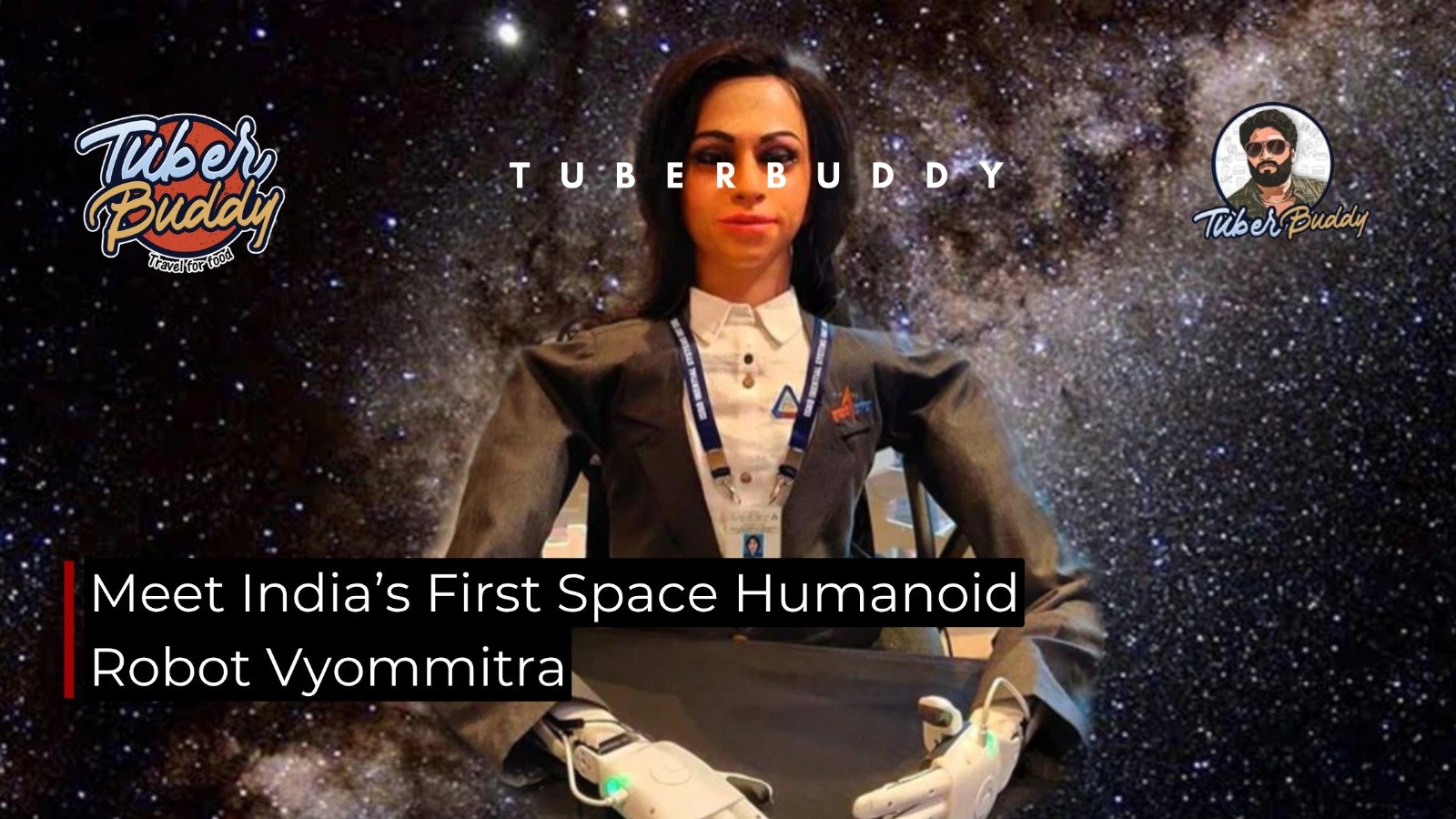Meet India’s First Space Humanoid Robot Vyommitra

Did you ever think of a robot wearing a space suit, greeting you in Hindi and English, smiling at you, and conducting scientific experiments onboard space?
This fantasy is now reality—meet Vyommitra, India’s first space humanoid robot, developed by ISRO (Indian Space Research Organisation).
This advanced creation represents India’s technological ability, human expertise, and the nation’s ambitious drive to send astronauts into space under the Gaganyaan Mission.
Who Is Vyommitra? The Name Origin
Vyommitra’s name has been coined from two Sanskrit words — “Vyoma” that refers to space and “Mitra” that refers to friend.
Thus as a whole, Vyommitra refers to “Friend in Space.”
She’s just that — a robotic friend who will assist scientists to observe conditions, assist astronauts, and even respond back to them during missions. Vyommitra will be made to appear and act like a human being — with a head, arms, eyes, and lips that curl into a smile. She’ll be capable of speaking, smiling, and even uttering “please” and “thank you,” responding with remarks like “Hello, I am Vyommitra, your robot space friend.”
The Origin of Vyommitra: ISRO’s Futuristic Dream
Vyommitra was first unveiled to the world in January 2020 at Bengaluru’s Human Spaceflight and Exploration Symposium.
When she first arrived, she won everyone’s heart immediately — not only because of her human-like face but also because of her assertive communication.
ISRO created Vyommitra as part of India’s Gaganyaan Mission, India’s first human spaceflight mission.
The objective is to launch Indian astronauts (Gagannauts) into space on an Indian spacecraft. To get ready to send humans, ISRO will test fly the spacecraft systems with unmanned missions — and Vyommitra will form part of those test flights.
What Can Vyommitra Do? The Intelligent Talents of India’s Space Robot
Vyommitra is not only a beautiful face — she is smart and holds state-of-the-art AI (Artificial Intelligence) and robotics technology.
Here’s what she can do:
1.Mimic Human Functions
Vyommitra can mimic the movements of the human body, obey commands, and even gesticulate.
She’s half-human — she doesn’t have legs but does have a torso, head, and arms that can carry out different functions.
2.Communicate and Interact
She can speak English and Hindi, salute astronauts, and even reveal mission information.
Her communication skills enable her to talk with the crew and mission control on Earth, qualifying her to be an appropriate space mission assistant.
3.Control Equipment and Conditions
Vyommitra is trained to control panels, check spacecraft environmental conditions, and read system parameters.
She can read parameter levels like cabin pressure, humidity, oxygen level, and temperature to check everything is in order.
4.Data Transfer to Earth
She can send critical real-time information to ISRO’s ground stations.
This enables scientists to track the functioning of spacecraft systems and make changes if needed.
5.Support Astronauts
During manned missions, Vyommitra will support astronauts in conducting routine checks, experiments, and communication tasks, lessening their workload.
Vyommitra and the Gaganyaan Mission
- The Gaganyaan Mission is India’s most ambitious space endeavor.
- It will take a three-member Indian crew to space for five to seven days on a 400 km Earth orbit.
- Two test flights with no humans on board — and Vyommitra will be inside one of them — will be flown by ISRO before humans will inhabit the spacecraft.
During these tests, Vyommitra will:
- Track spacecraft performance
- Perform microgravity experiments
- Test life-support systems
- Talk to mission control
Her performance will also assist ISRO in ascertaining that all systems are in place and safe to launch human astronauts.
Why Is Vyommitra So Important?
Vyommitra isn’t simply a robot — she’s the connector between technology and humankind in India’s space future. Here’s why she’s important:
1.Safety First
By launching Vyommitra ahead of human astronauts, ISRO can experiment with spacecraft systems safely without endangering human lives.
2.Experimentation in Space
She can conduct scientific experiments in weightlessness and provide data that can enlighten scientists regarding space conditions in a superior manner.
3.Step Towards Completely Autonomous Missions
Vyommitra is a step towards AI-enabled or completely autonomous space missions, minimizing the dependence on constant human intervention.
4.Symbol of India’s Technological Development
Her invention proves that India is joining a global club of nations working on humanoid technology for space like the USA, Russia, and Japan.
The Human Touch: How Vyommitra Brings Emotionally Alive
One of the most fascinating aspects of Vyommitra is that she has a human personality. She is able to:
- Smile in a polite manner
- Look into your eyes
- Talk softly and kindly
- Be empathetic in her reaction
This personalization is not accidental — ISRO engineers created it with the express purpose of making astronauts feel more at ease and less lonely during long-duration spaceflights.
Space can, after all, be an isolating place, and having a “space friend” like Vyommitra may help to provide emotional consolation too.
Behind the Scenes: The Technology That Drives Vyommitra
The sophisticated features of Vyommitra are driven by:
Artificial Intelligence (AI) – to support speech, decision-making, and execution
Machine Learning (ML) – so that she can learn and develop
Voice Recognition Systems – so that she can be simply spoken to and replied back to
Sensors and Cameras – so that she can observe things and gain information
Embedded Systems – that manage her movements and operations
Her slender form, expressive face, and human-like behavior were designed through cutting-edge robotics engineering — so that she is both functional and personable.
The Global Context: Space-Traveling Humanoid Robots
India is not the only one launching a humanoid into space, but Vyommitra has a twist of her own.
This is where she measures up to her global peers:
Country
Robot
Mission/Role
USA
Robonaut (NASA)
Assisted astronauts on the ISS
Japan
Kirobo (JAXA)
Talking robot friend
Russia
Fedor
Operated spacecraft systems
India
Vyommitra
First Indian humanoid for space exploration
Other machines were primarily mechanical or showpiece in nature, but Vyommitra merges science, emotion, and communication — a rewarding synergy of technology and sympathy.
What's Next for Vyommitra?
- Vyommitra is being given final training and testing for her next unmanned Gaganyaan mission.
- Once the flight is successful, she will mark the way for India’s first manned space mission.
Future plans can even feature:
- More sophisticated humanoids with locomotion (legs)
- AI technologies for deep-space exploration
- Joint ventures with humans and robots in conjunction
Vyommitra: A Ray of India’s Future
- Vyommitra is not just a robot — she’s a ray of the faith of India in technology and innovation.
- She proves that science doesn’t necessarily imply machines but working on something touching humans.
- Her odyssey from the planet Earth to the cosmos is India’s dip into the future — one in which man and machine intelligence unite hand in hand to explore the galaxy.
- With India gearing up for the Gaganyaan mission, Vyommitra makes us understand that the future of space travel is not only mechanical — it is emotional, intelligent, and man-powered.
Last Thoughts
Vyommitra’s creation is not only an engineering wonder — it’s a national inspiration.
She represents curiosity, wit, and compassion — all we value in humans and machines.
When Vyommitra eventually launches on the Gaganyaan spacecraft, she will not be just carrying scientific equipment.
She will be carrying the dreams, hopes, and voice of a nation wanting to touch the stars.
For more stories that connect past and present, Follow Tuber buddy
